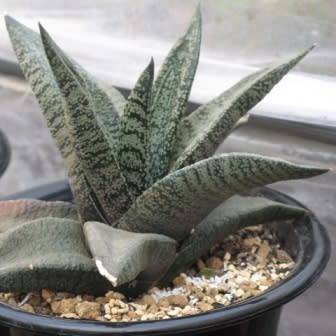
















5 Gasteria ellaphieae Seeds - Indigenous South African Endemic Succulent - Combined Global Shipping
Check my rate
| Main centres: | 1-3 business days |
| Regional areas: | 3-4 business days |
| Remote areas: | 3-5 business days |

















| Main centres: | 1-3 business days |
| Regional areas: | 3-4 business days |
| Remote areas: | 3-5 business days |

Gasteria ellaphieae Seeds
South African Endemic Succulent

Gasteria is a genus of 23 species of succulent plants indigenous to South Africa with all except one being endemic to South Africa. Closely related genera include Aloe, Astroloba and Haworthia. The genus name Gasteria is named for its stomach-shaped flowers. In Greek, gaster, means belly, and alludes to the swollen base of the perianth tube. The genus is part of the family Asphodeloideae. Common names include cow-tongue cactus, lawyer's tongue, mother-in-law's tongue and ox-tongue. Gasteria species are grown in well-drained, sandy soils in light shade. Gasterias thrive in cultivation both indoors and outdoors, used as potted plants or in outdoor rockeries and are tolerant of a wide range of soils and habitats. The flowers attract birds to the garden during spring. With their ability to grow under lower light conditions they are easily grown and maintained in cultivation. Numerous intergeneric beautiful hybrids are known. Regrettably they are almost always sterile and cannot be propagated from seed. Some of the well-known hybrids include crosses with Aloe, Astroloba and Haworthia to make genera such as Gasteraloe, Gastroloba and Gasterworthia. Gasterias are used in various traditional medicines. In the Eastern Cape Gasteria excelsa and Gasteria croucheri are said to have magical properties and are occasionally put on the roofs of homes to stop lightning from striking the house. There are also reports that the plants are used during faction fighting in a belief that it will make them invisible to their enemies. Gasteria ellaphieae is a dwarf aloe-like, succulent-leaved rock crevice plant endemic to the Kouga Dam region of the Eastern Cape Province. It thrives in cultivation. It is a cliff dweller that grows on shady, sheer rocky slopes. It grows together with Haworthia viscosa and Haworthia isabellae. Gasteria ellaphieae is one of the most popular and sought after species with propeller shaped rough leaves. They are usually solitary plants, up to 18 cm in diameter. The leaves are initially spreading in two opposite rows but then begin to spiral with age. When adult, this small plant has thick, rough-textured, triangular-lanceolate leaves. Both surfaces are dark-green taking on a reddish colour in strong light and mottled with dense white tubercles.

